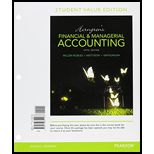
Concept explainers
Double-declining-balance method: It is an accelerated method of
To identify: which depreciation method ignores residual value until the last year of depreciation.
To explain: the reason for ignoring the residual value until the last year of depreciation.
Want to see the full answer?
Check out a sample textbook solution
Chapter 9 Solutions
Horngren's Financial & Managerial Accounting, Student Value Edition Plus MyLab Accounting with Pearson eText -- Access Card Package (5th Edition)
- Hi expert please given correct answer with general accounting questionarrow_forwardCan you explain this financial accounting question using accurate calculation methods?arrow_forwardMerin Manufacturing produces a single product and follows a JIT policy where ending inventory must equal 20% of the next month's sales. It estimates that July's ending inventory will consist of 32,000 units. August and September sales are estimated to be 210,000 and 225,000 units, respectively. Merin assigns variable overhead at a rate of $4.25 per unit of production. Fixed overhead equals $385,000 per month. Compute the number of units to be produced and the total budgeted overhead that would appear on the factory overhead budget for the month of August.arrow_forward
- Nina Manufacturing had a Work in Process balance of $79,000 on January 1, 2021. The year-end balance of Work in Process was $87,000 and the Cost of Goods Manufactured was $560,000. Use this information to determine the total manufacturing costs incurred during the fiscal year 2021.arrow_forwardFind outarrow_forwardHello tutor please given General accounting question answer do fast and properly explain all answerarrow_forward
- Quintana Corporation projected current year sales of 42,000 units at a unit sale price of $32.50. Actual current year sales were 39,500 units at $33.75 per unit. Actual variable costs, budgeted at $22.75 per unit, totaled $21.90 per unit. Budgeted fixed costs totaled $375,000, while actual fixed costs amounted to $392,000. What is the sales volume variance for total revenue? I want answerarrow_forwardWhat is hemingway corporation taxable income?arrow_forwardThe manufacturing operations of Denton labels inc. for the year.arrow_forward
 College Accounting, Chapters 1-27AccountingISBN:9781337794756Author:HEINTZ, James A.Publisher:Cengage Learning,
College Accounting, Chapters 1-27AccountingISBN:9781337794756Author:HEINTZ, James A.Publisher:Cengage Learning, Intermediate Accounting: Reporting And AnalysisAccountingISBN:9781337788281Author:James M. Wahlen, Jefferson P. Jones, Donald PagachPublisher:Cengage Learning
Intermediate Accounting: Reporting And AnalysisAccountingISBN:9781337788281Author:James M. Wahlen, Jefferson P. Jones, Donald PagachPublisher:Cengage Learning


